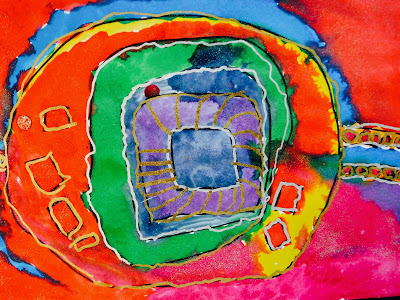Each year
at Mairtown, beginning in term 3, something exciting happens; the children
begin creating their own individual art pieces ready to make into calendars,
cards and diaries. This is a time of year that I love as a teacher at Mairtown;
I love sitting down with each child, supporting them as they create, watching
as their pieces unfold and noticing the pride and sense of accomplishment on
each child’s face when they finally finish (after many days of effort).
At
Mairtown, art and creativity is a very important aspect of our programme. We
don’t see art as a rainy day activity or set our children up to create art
pieces that all look the same and follow the same process, instead we cherish the
arts. We offer children creative art experiences every single day, we provide
good quality resources and support children as they begin their learning in the
arts so they are successful, competent and proud of their effort and creations.
As we began
our calendar work again this year, we called upon one of our favourite artists,
one that our Mairtown children are true experts on, that of Friedensreich
Hundertwasser. We have many lovely books at Kindergarten illustrating
many of Hundertwasser's work, so the children were able to begin their work by
choosing a piece of his that really captured their imagination and curiosity. When
I sit and talk to the children about Hundertwasser's art pieces one thing I
notice is how the children are naturally drawn to his use of bright, vibrant
colours and how they interpret his pieces each in a very individual way, many
seeing stories (they like to share with friends) in his work. I always encourage the children to dream and imagine, to tell and
share their stories, to think about what a picture could be rather than what it
is, as I firmly believe this strengthens their imaginative and critical
thinking skills.
The creative arts are often thought of as unimportant, and are
frequently the first programs to be cut when funds are low. However, the
creative arts not only cultivate children’s imaginations, so that they become
more flexible and inventive thinkers, but also help to develop their physical,
emotional, and mental capabilities. As such, it is imperative that we work to
integrate greater chances for young children to engage in the creative arts,
for such measures will provide the foundation for later success (Chen,
2016)
What is so lovely about this kind of art is that as teachers
we are able to work with just one or two children at a time. This allows us to thoroughly
discuss and examine in depth the art that has provoked each child and we are
part of witnessing, listening and observing each child’s creative wonderings. Over
the months we engage with children on this work we can also see how children
develop skills of sharing ideas, of using their imaginations and of building up
a collection of ideas that ultimately enable them to see and appreciate perspectives
which are different to their own.
‘Children’s interest in making art is increased if
adults encourage them to talk about art and artists – who artists are and how
they make things’ (Douglas, Schwartz and Taylor, 1981).
Despite inviting all our children to create a piece of art,
a busy time for us, we are very mindful as teachers to support the children in
an unhurried manner, never to rush or push their creativeness at a pace the
children are not happy or comfortable with. Art pieces such as these take a
great deal of time. We begin work with black vivid, later adding coloured dye
and finishing with highlights of gold and silver pens. Although only seemingly
a three step process, for children, who are still developing strength in the
small muscles of their fingers, each step may be broken down into several more
steps. Whilst some children love to try and finish so they can see their
finished product, others take longer, enjoying the process of contemplation, of
re-visiting, of adding on a little here and there, of watching their art pieces
slowly develop.
‘Play and the creative arts
in early childhood programmes are essential ways children communicate, think,
feel and express themselves…Children succeed when they have access to a wide
variety of art-making materials…and when they are surrounded by adults who see
and believe in the creative competence of all children and are committed to
their success in expressing themselves…Given these optimum circumstances,
children surprise and delight us – they create structures and thoughts no one
has seen or heard before’ (Drew and Rankin, 2004).
For many
children creating an artistic piece is a risk and a challenge, and again
working one-on-one or in small groups allows us as teachers to support these
children in their endeavours to take that risk, to try and to experiment, after
all this is how we gain the confidence in life that anything is possible.
Although
we may have used Hundertwasser’s art as a provocation for the children’s work,
I feel it is still vital for the children to make their own choices. In this year’s
work, some of our children decided not to use Hundertwasser but created work inspired by the things that interest them personally. Each child has approached
his/her creation differently; there was no right or wrong way to begin or to
finish and as such the pieces once again this year are totally stunning.
Here
are a few of this year’s collection I’d like to share with you:
At Mairtown we see all children as creative – full of
imagination and wonder. We provide children with the tools to fuel their
imaginations and to explore the language of art, I hope you have enjoyed
looking at this year’s art, and know many of you will have some of these wonderful
pieces hanging on your walls come the new year.




















No comments:
Post a Comment